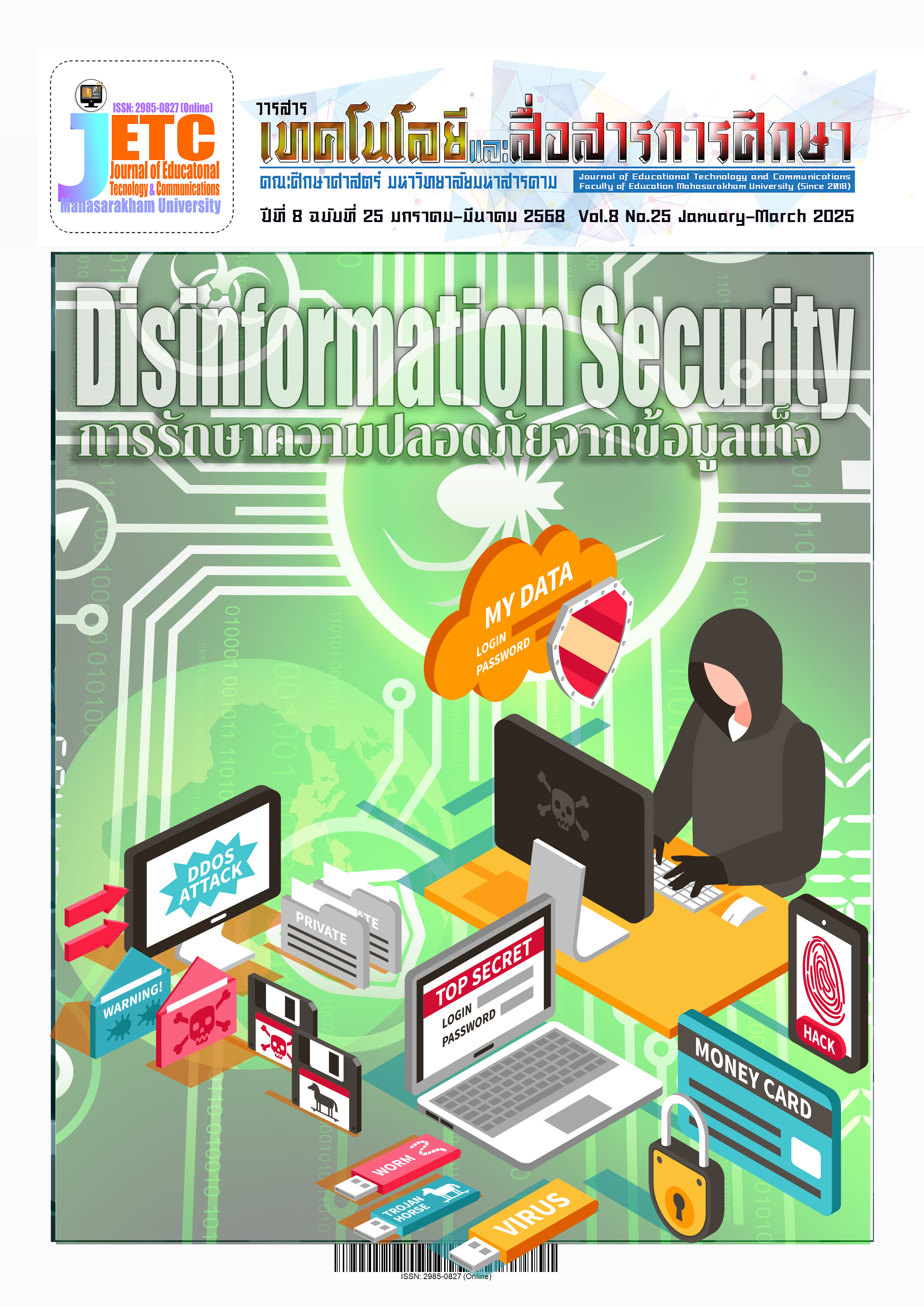Development of Learning Management Through Digital Storytelling in Gamification to Promote the Ability to Innovation in Teaching and Learning of Pre-Service Teacher
Main Article Content
Abstract
This research aimed to: 1) assess creative teaching and learning innovation abilities of pre-service teachers in in two aspects: 1.1) To evaluate the ability to innovative teaching materials. 1.2) To evaluate the ability to creative learning management. 2) To study pre-service teachers’ opinions on the teaching and learning activities. The sample consisted of 23 pre-service teachers from the Faculty of Education, Silpakorn University who enrolled in the 451302-162 Mathematics Learning Management for primary education course during the first semester of the 2023 academic year. The participants were selected using cluster random sampling. Research instruments included: 1) an evaluation of innovative teaching materials abilities, 2) an evaluation of creative learning management abilities, and 3) a questionnaire on students’ perceptions of the learning management process. Data were analyzed using mean (𝑥̅), and standard deviation (S.D). The instruction via digital storytelling in gamification consists of five steps that are 1) targeted 2) reach 3) accrue 4) develop and 5) expand.
The results of the research revealed that:
1. creative teaching and learning innovation abilities of pre-service teachers. 1.1 the overall ability to innovative teaching materials is at a very good level (𝑥̅= 2.71,S.D.= 0.36). 1.2 the overall ability to creative learning management are at a very good level (𝑥̅= 3.21, S.D.= 0.52).
2.the opinions level of the pre-service teacher on the improvement of instructed overall is at an excellent level (𝑥̅= 4.67,S.D.= 0.49).
Downloads
Article Details
References
กระทรวงศึกษาธิการ. (2562). ประกาศกระทรวงศึกษาธิการ เรื่อง มาตรฐานคุณวุฒิระดับปริญญาตรี สาขาครุศาสตร์และสาขาศึกษาศาสตร์ (หลักสูตรสี่ปี) พ.ศ. 2562.
กฤตพล วังภูสิต. (2564). รูปแบบการเรียนการสอนภาษาและวัฒนธรรมตามแนวภูมิทัศน์เชิงภาษาศาสตร์เพื่อส่งเสริมความสามารถการสร้างนวัตกรรมเชิงสร้างสรรค์ของนักศึกษาครู. [วิทยานิพนธ์ปริญญาดุษฎีบัณฑิต, มหาวิทยาลัย ศิลปากร]. https://sure.su.ac.th/xmlui/bitstream/handle/123456789/26791/DR_กฤตพล_วังภูสิต.pdf
กฤษณพงศ์ เลิศบำรุงชัย. (2566, 8 มกราคม). เกมิฟิเคชั่น (Gamification) โลกแห่งการเรียนรู้ที่ขับเคลื่อนด้วยเกม. https://touchpoint.in.th/gamification/
กิ่งกาญจน์ บูรณสินวัฒนกูล. (2562). การพัฒนาสื่อการเรียนรู้บอร์ดเกมการศึกษาเพื่อส่งเสริมความสามารถการเรียนรู้ ในรายวิชาพัฒนาการแบบเรียนภาษาไทยและ ความสุขในการเรียนรู้สำหรับนิสิตระดับปริญญาตรี. มหาวิทยาลัยศรีนครินทรวิโรฒ.
กุลิสรา จิตรชญาวณิช. (2562). การจัดการเรียนรู้. สำนักพิมพ์จุฬาลงกรณ์มหาวิทยาลัย.
ฐิติ อติชาติชยากร. (2565). การพัฒนารูปแบบสภาพแวดล้อมการเรียนรู้บนคลาวด์โดยใช้กระบวนการคิดเชิงออกแบบร่วมกับ แนวคิดเกมมิฟิเคชันเพื่อส่งเสริมความสามารถในการสร้างสรรค์นวัตกรรมการบริการในห้องสมุดของ นิสิต สาขาสารสนเทศศึกษา. [วิทยานิพนธ์ปริญญาดุษฎีบัณฑิต, จุฬาลงกรณ์มหาวิทยาลัย]. https://digital.car.chula.ac.th/cgi/viewcontent.cgi?article=11150&context=chulaetd
ทิศนา แขมมณี. (2564). ศาสตร์การสอน : องค์ความรู้เพื่อการจัดกระบวนการเรียนรู้ที่มีประสิทธิภาพ (พิมพ์ครั้งที่ 25). สำนักพิมพ์แห่งจุฬาลงกรณ์มหาวิทยาลัย.
เธียรดนัย เสริมบุญไพศาล. (2562). การพัฒนากระบวนการเรียนการสอนตามแนวคิดการวางแผนกลยุทธ์และการคิดนอกกรอบ เพื่อ ส่งเสริมความสามารถในการสร้างนวัตกรรมทางเคมีของนักศึกษาระดับปริญญาบัณฑิต. [วิทยานิพนธ์ปริญญาดุษฎีบัณฑิต, จุฬาลงกรณ์มหาวิทยาลัย]. https://digital.car.chula.ac.th/cgi/viewcontent.cgi?article=10811&context=chulaetd
นริศรา พรมริน. (2565). ผลการใช้กิจกรรมการเรียนรู้การเล่าเรื่องแบบดิจิทัล (Digital Storytelling) เพื่อส่งเสริมความสามารถในการอ่านภาษาอังกฤษเพื่อความเข้าใจ ของนักเรียนชั้นมัธยมศึกษาปีที่ 6 [วิทยานิพนธ์ปริญญา มหาบัณฑิต, มหาวิทยาลัยศิลปากร]. http://ithesis-ir.su.ac.th/dspace/handle/123456789/4307
ประกาศคณะกรรมการคุรุสภา เรื่อง สาระความรู้ สมรรถนะและประสบการณ์วิชาชีพของผู้ประกอบวิชาชีพครูผู้บริหารสถานศึกษา ผู้บริหารการศึกษา และศึกษานิเทศก์ ตามข้อบังคับคุรุสภา ว่าด้วยมาตรฐานวิชาชีพ พ.ศ. 2556. (2556, 12 พฤศจิกายน). ราชกิจจานุเบกษา. เล่มที่ 130 ตอนพิเศษ 156ง. หน้า 47-49.
พิชิต ฤทธิ์จรูญ. (2559). เทคนิคการวิจัยเพื่อพัฒนาการเรียนรู้. เอกสารการสอนชุดวิชานวัตกรรมการสื่อสารเพื่อการพัฒนาเด็กปฐมวัย หน่วยที่1-15. สาขาวิชาศึกษาศาสตร์ มหาวิทยาลัยสุโขทัยธรรมาธิราชโรงพิมพ์แห่งจุฬาลงกรณ์มหาวิทยาลัย.
รังสรรค์ โฉมยา และสมบัติ ท้ายเรือคํา. (2565). คุณภาพของนวัตกรรมการศึกษา: การรื้อปรับโครงสร้างทางแนวคิด. Journal of Education Naresuan University, 24(4), 339-349. https://so06.tci-thaijo.org/index.php/edujournal_nu/article/view/248872
วรมณ ช่อไม้ทอง. (2564). การจัดการเรียนรู้โดยใช้การสร้างเรื่องเล่าแบบดิจิทัลตามแนวคิดคอนสตัคชันนิซึม เพื่อส่งเสริมความคิดสร้างสรรค์ของนักเรียนชั้นประถมศึกษาปีที่ 4 โรงเรียนสาธิตมหาวิทยาลัยศรีนครินทรวิโรฒ ประสานมิตร (ฝ่ายประถม). [วิทยานิพนธ์ปริญญามหาบัณฑิต, มหาวิทยาลัยศรีนครินทรวิโรฒ]. http://ir-ithesis.swu.ac.th/dspace/handle/123456789/1503
วัชราภรณ์ ประภาสะโนบล. (2565). รูปแบบการพัฒนาสมรรถนะการจัดการเรียนรู้ของนักศึกษาครูโดยใช้โครงงานเป็นฐานร่วมกับการสอนแบบสร้างสรรค์เพื่อเสริมสร้างความสามารถในการสร้างสรรค์นวัตกรรมของนักเรียน. [วิทยานิพนธ์ปริญญาดุษฎีบัณฑิต, มหาวิทยาลัยศิลปากร]. http://ithesis-ir.su.ac.th/dspace/handle/123456789/3881
สำนักส่งเสริมวิชาการและงานทะเบียนมหาวิทยาลัยราชภัฏวไลยอลงกรณ์ในพระบรมราชูปถัมภ์. (2557). คู่มือการจัดระบบการเรียนการสอนที่ยึดผู้เรียนเป็นสำคัญ. (พิมพ์ครั้งที่ 2). ศูนย์เรียนรู้การผลิตและจัดการธุรกิจสิ่งพิมพ์ดิจิตอล มหาวิทยาลัยราชภัฏวไลยอลงกรณ์ในพระบรมราชูปถัมภ์.
สุเทพ อ่วมเจริญ. (2557). การเรียนการสอน : การออกแบบ นวัตกรรมและเทคโนโลยี. โรงพิมพ์มหาวิทยาลัยศิลปากร.
อัญญารัตน์ สอนสนาม, สมพร วงษ์เพ็ง, ภาวินี อ่างบุญตา, สุภารัตน์ บุตรไชย และธนัช ศรีพนม. (2565). การพัฒนารูปแบบการจัดการเรียนรู้เชิงรุก (Active Learning) ร่วมกับการเรียนรู้ผ่าน Google Sites รายวิชาวัสดุอุตสาหกรรมและการผลิต. Journal of Modern Learning Development, 7(9), 327-340. https://so06.tci-thaijo.org/index.php/jomld/article/view/259510
Bonwell, C. C., & Eison, J. A. (1991). Active learning: creating excitement in the classroom Washington, D.C: School of Education and Human Development. George Washington University.
Bryant, P. (2023). Student experience and digital storytelling: Integrating the authentic interaction of students work, life, play and learning into the co‑design of university teaching practices. Education and Information Technologies, 28,14051–14069. https://doi.org/10.1007/s10639-022-11566-8
Huang, W. H.-Y., & Soman., D. (2013). A practitioner’s guide to gamification of education. Rotman School of Management University of Toronto.
Irhadtanto, B., Rohmah, I.I.T., Junarti, Cuhanazriansyah, M.R., & Cahyaningrum, Y. (2024). Implementation of Educational Technology Based on Gamification in Interactive Monopoly Games in the 4.0 Era. International Journal of Interactive Mobile Technologies (iJIM), 18(18), pp. 157–166. https://doi.org/10.3991/ijim.v18i18.50549
Kapp, K. M. (2012). The Gamification of Learning and Instruction: Game-based Methods and Strategies for training and education. San Francisco: CA L Pfeiffer.
Morra, S. (2023, January 20). 8 Steps to great digital storytelling. https://samanthamorra.com/2013/06/05/edudemic-article-on-digital-storytelling/
Ohler, J. B. (2013). Digital storytelling in the classroom : New Media Pathways to Literacy, Learning, And Creativity (2nd ed). California: Thousand Oaks.
Saunila, M., & Ukko, J. (2012). A conceptual framework for the measurement of innovation Capability and its effects. Baltic Journal of Management, 7(4), 355-375. http://dx.doi.org/10.1108/17465261211272139

